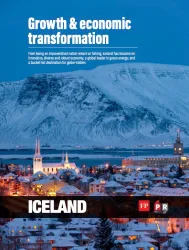Iceland: Growth and economic transformation
From being an impoverished nation reliant on fishing, Iceland has become an innovative and diverse economy, a leader in green energy and a bucket-list destination for globe-trotters.

Photo Credit: Shutterstock
Iceland celebrated its 80th anniversary as an independent republic last year with a flourishing economy and one of the highest gross domestic product per capita ratios worldwide. This reflects an extraordinary turnaround that has seen the country develop a diverse export mix.
Today, tourism is Iceland’s biggest foreign currency earner. “Tourism has been outgrowing other export industries. The country is spectacular all year,” explains Pétur Þ. Óskarsson, CEO of Business Iceland, the investment, trade and tourism promotion agency. Iceland’s main attraction is stunning natural environments, including volcanoes, glaciers, hot springs and clear skies offering amazing views of the Northern Lights. The country also boasts a vibrant cultural scene, which Business Iceland promotes abroad. “Many Icelandic musicians, visual artists and authors have made a splash on the international stage, and our film industry is booming,” Óskarsson notes.

Pétur Þ. Óskarsson,
CEO, Business Iceland
Traditional industrial export pillars are performing well too. “There is strong global demand for Icelandic seafood that is sustainably fished from the pure waters of the North Atlantic, and Iceland has unique environmental conditions for land-based aquaculture, including ample clean water and energy,” he says.
All the island’s electricity and heating are generated from hydroelectric and geothermal sources, and technologies developed in those areas are a further key segment of its export portfolio. “We’re a role model to the world when it comes to the production of green energy,” Óskarsson states. “Overall, Iceland has seen a dramatic shift toward innovation and technology-based industries.”
Internationalized innovation at its core
The establishment of innovation-led exports as a new pillar of the economy is strongly correlated to Iceland’s R&D annual expenditure shooting up from 2.2% of GDP to around 2.8% since 2015. The Icelandic Centre for Research (RANNIS) has been a crucial catalyst of this growth in spending, as the public entity responsible for national funding of research and innovation, as well as coordinating Iceland’s participation in international cooperative agreements, such as the EU’s Horizon research program.
The institute is also tasked with ensuring that incentives for R&D are allocated appropriately. “The biggest tool that the government has is the tax deduction and refund scheme for research and innovation,” asserts Ágúst Hjörtur Ingþórsson, RANNIS’s director general. This scheme is one of the most generous worldwide, according to the OECD, with up to 35% of R&D activities being tax deductible.
Ingþórsson believes there is substantial potential for greater R&D cooperation between Iceland and the U.S., particularly in Arctic issues, sustainability and energy: “Iceland is really keen on developing strong international collaboration, and we offer a very receptive research and innovation environment. ‘Opportunity’ is the word that sums up what Iceland stands for now.”
Harvesting energy from the Earth
The U.S. would benefit from sharing Iceland’s knowledge in geothermal energy, which it has been exploiting for decades. Tómas Már Sigurðsson, CEO of the nation’s third-largest energy company, HS Orka, explains that “Iceland’s location between two tectonic plates gives it access to active geothermal areas along a volcanic belt. These provide both steam and hot water, which we use to heat buildings and generate electricity.”

Tómas Már Sigurðsson,
CEO, HS Orka
HS Orka has two geothermal plants with a combined 196MW of installed energy capacity and two hydro facilities that contribute 20MW, which supply the population with hot and cold water and electricity. The firm is also a trailblazer in zero-waste energy.
“HS Orka has prioritized sustainability by fully utilizing all geothermal resources. Our plants produce not only electricity, steam and hot water, but also heat, brine and carbon dioxide that support numerous businesses,” Sigurðsson says.
To facilitate this, the company set up the pioneering Resource Park near its geothermal plants. Enterprises currently based there operate in sectors such as food, aquaculture, cosmetics, skincare, biotechnology, the energy transition and tourism. “We’ve created a circular economy model, generating jobs, export revenue and growth,” he enthuses.
Data centers: Sustainable and cost-effective

Photo Credit: Shutterstock
The country’s green power contributes to its strong value proposition for data centers, as does a cold climate that enables efficient cooling and low energy consumption, great digital connectivity and being highly ranked for data safety. Geography is another plus, according to Björn Brynjúlfsson, CEO of Borealis Data Center, a specialist in colocation, high-performance computing and artificial intelligence data center solutions, which operates three campuses across the country and one in Finland. “With our location between Europe and the U.S., we’re naturally placed to serve both of those markets,” he says.
Borealis has leveraged Iceland’s advantages to support its growth. “We have a twofold strategy to continue expanding our sustainable solutions: external expansion and internal value creation,” Brynjúlfsson discloses. In 2023, it became Iceland’s first colocation operator to be recognized by the international Open Compute Project as “OCP Ready,” confirming its ability to support intensive workloads efficiently and sustainably. It also holds three ISO certification for information security, cloud activities and data-protection compliance.
The CEO is confident that the sector will carry on expanding rapidly: “Iceland has the capabilities to be one of the world’s leading data center hubs and Borealis is well equipped to be instrumental in making that a reality.”
Free-roaming Icelandic lamb: A star on a plate
Agriculture is a much older, but no less vital, economic contributor. Among the many foods and drinks created in Iceland, it is best known for lamb, the country’s first product to gain Europe’s protected designation of origin status, putting it in the same elite category as France’s champagne and Italy’s Parma ham. This reflects its quality and uniqueness, says Haflidi Halldórsson, CEO of Icelandic Lamb, a farmers’ marketing agency promoting the lamb both locally and under the umbrella of Inspired by Iceland, which promotes the nation’s most outstanding outputs abroad.
Sheep farming has been engrained in the country’s culture for around 1,100 years, with all sheep hailing from one pure breed. They spend their lives freely and organically grazing in pristine countryside, which makes Icelandic lamb exceptionally lean, tender and enticingly flavored by herbs, berries and grass.
Only around 400,000 sheep roam the nation’s meadows, and it is hard to find the meat abroad. “Future lamb exports would most likely be small scale and niche,” Halldórsson reveals. “However, an incredibly high number of Americans eat lamb when they travel to Iceland.” He is optimistic about the farming sector generally: “Icelandic agriculture has substantial potential. We have lots of land, water and green energy.”
To discover more about Iceland’s vast potential in a wide variety of industries, download our full-length special.
The Foreign Policy editorial team had no role in the creation of this content.

 Download the PDF
Download the PDF